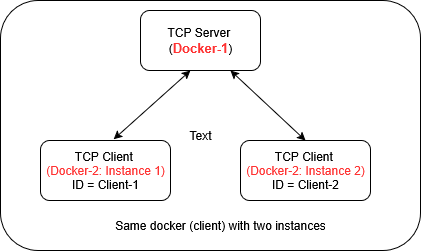A more complex example (TCP Server/Client)
1.The objective
In this example, we are creating TWO docker apps. - Docker 1: To run a TCP Server - Docker 2: To run a TCP Clinet that connects to the above server - The server starts and waits for a connection request from client(s)

-
When a TCP client connects to the server and passes its ID name to the server (e.g. TClient-1, TClient-2), which is passed through a command line.
-
The server in turn, sends a greeting message to each client Hello from server to TCLinet1---Msg #
-
Additionally, we can run multiple instances of client docker, and server handles each of them with their own greeting message.
2. Directory structure
Create the following directory structure. Refer to the previous tutorial Hello Docker if you need a refresher.
# we do not need any extra modules other than the standard ones
# so we are removing requirments.txt file completely
tcp-docker-app/
├── server/
│ ├── server.py
│ └── Dockerfile
└── client/
├── client.py
└── Dockerfile
3. File contents
Server (Python)
server/server.py
import socket
import time
HOST = '0.0.0.0'
PORT = 5000
def start_server():
with socket.socket(socket.AF_INET, socket.SOCK_STREAM) as s:
s.bind((HOST, PORT))
s.listen(1)
print(f"[SERVER] Listening on {HOST}:{PORT}")
conn, addr = s.accept()
with conn:
print(f"[SERVER] Connected by {addr}")
counter = 1
while True:
message = f"hello-client1-msg {counter}\n"
conn.sendall(message.encode())
print(f"[SERVER] Sent: {message.strip()}")
counter += 1
time.sleep(1)
if __name__ == "__main__":
start_server()
Server (Dockerfile)
server/Dockerfile
Client (Python)
client/client.py
import socket
SERVER_HOST = 'server-container' # container name of the server
SERVER_PORT = 5000
def start_client():
with socket.socket(socket.AF_INET, socket.SOCK_STREAM) as s:
print(f"[CLIENT] Connecting to {SERVER_HOST}:{SERVER_PORT}")
s.connect((SERVER_HOST, SERVER_PORT))
while True:
data = s.recv(1024)
if not data:
break
print(f"[CLIENT] Received: {data.decode().strip()}")
if __name__ == "__main__":
start_client()
Client (Docker file)
client/Dockerfile
4. Build docker images
server
client
Verify the build
If everything was built correctly, you should see an output:REPOSITORY TAG IMAGE ID CREATED SIZE
tcp-client latest 3a7e23eb624a 59 seconds ago 127MB
tcp-server latest 8aa392e6b1e3 About a minute ago 127MB
5. Run (server, client, network)
Create a docker network
Run the server container
In Terinal-1
Run the Client container (1)
In Terminal-2
sudo docker run --rm -it --name client-container1 --network tcp-net tcp-client python client.py Client-1
Run the Client container (2)
In Terminal-2